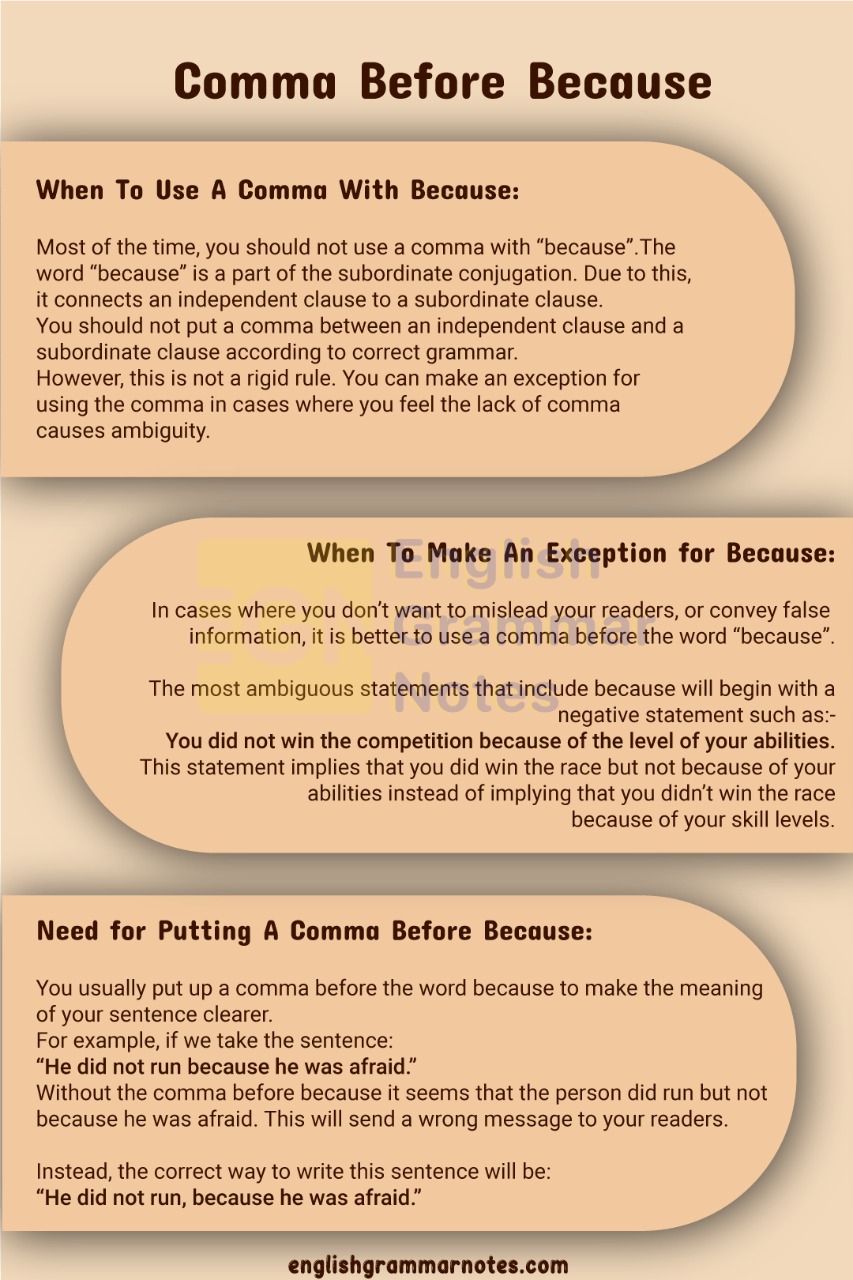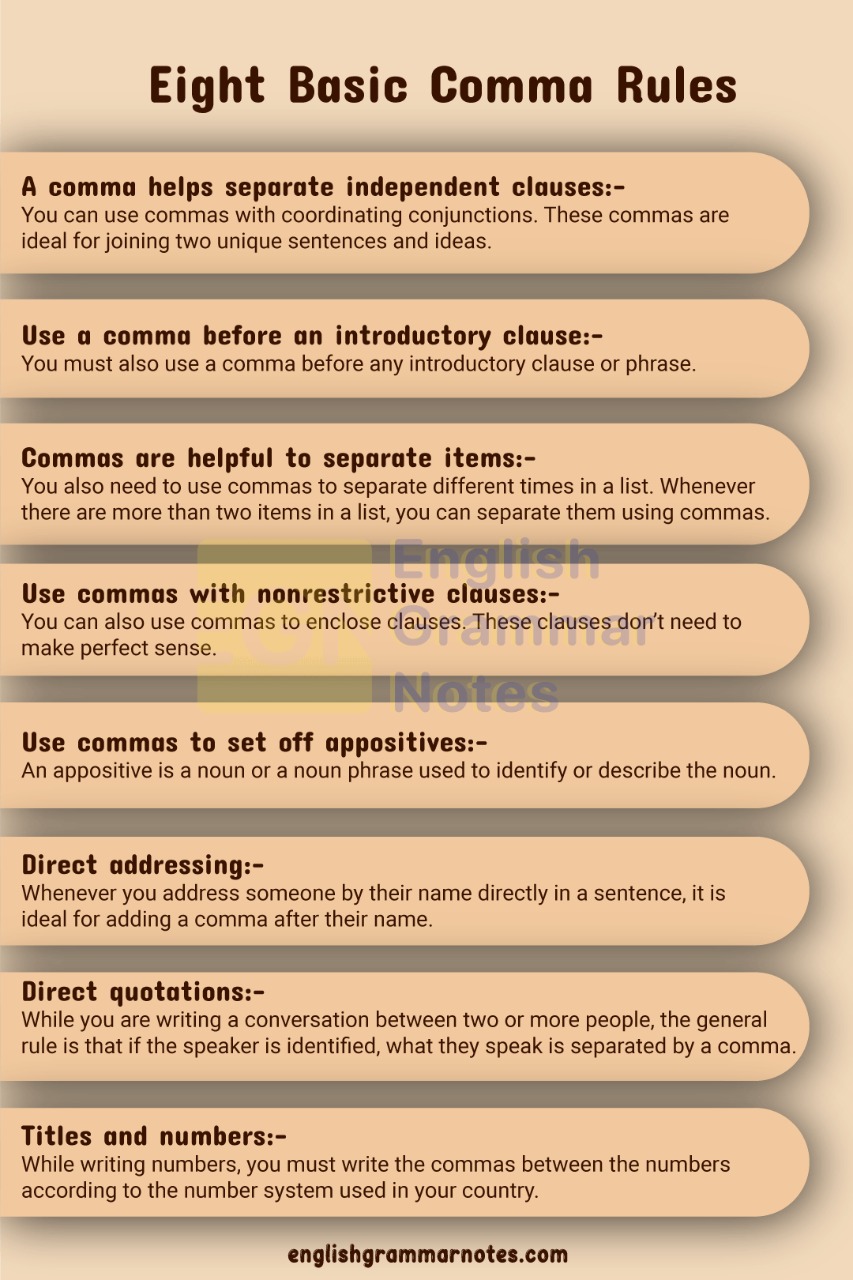Comma Before Because: If you regularly type or write a lot of stuff, you must have gone through phases where you are unsure what to write and what not to write. Grammatical correctness and knowledge are some of the most critical aspects of your written material.
Most people cannot move past or ignore your grammatical mistakes even if your content is excellent. One common mistake that people face is knowing when to use a comma before “because”.
This article will provide you with the essential knowledge and insight on how and when you should use your commas while writing something.
Using Comma Before Because
- When To Use A Comma With Because
- When To Make An Exception for Because
- Need for Putting A Comma Before Because
- Rules for Using Commas To Improve Your Writing
- Commas and Conjugation
- Eight Basic Comma Rules
- Conclusion on Comma Before Because
When To Use A Comma With Because
Most of the time, you should not use a comma with “because” When it is used to connect or join two clauses in a sentence. The word “because” is a part of the subordinate conjugation. Due to this, it connects an independent clause to a subordinate clause.
You should not put a comma between an independent clause and a subordinate clause according to correct grammar.
However, this is not a rigid rule. You can make an exception for using the comma in cases where you feel the lack of comma causes ambiguity.
You can also use the word because of conjugation. Its purpose is to introduce a clause of purpose in the sentence. Usually, you will find sentences that begin with because are used as answers to the questions beginning with why?.
Since why is already subordinate to the independent clause, there should be no commas between these words.
When To Make An Exception for Because
In cases where you don’t want to mislead your readers, or you don’t want to convey false information, it is better to use a comma before the word “because”—using a comma before because will decrease the ambiguity in your sentences and will make it simpler to understand.
The most ambiguous statements that include because will begin with a negative statement such as:-
You did not win the competition because of the level of your abilities.
This statement implies that you did win the race but not because of your abilities instead of implying that you didn’t win the race because of your skill levels.
Without a comma, there is no relationship between your victory and the ability, but if you add a comma before “because,” the result of the competition and your ability levels will be linked together due to the word “because”.
Need for Putting A Comma Before Because
You usually put up a comma before the word because to make the meaning of your sentence clearer.
For example, if we take the sentence
“He did not run because he was afraid.”
Without the comma before because the meaning of this sentence is not clear. It seems that the person did run but not because he was afraid. This will send a wrong message to your readers.
Instead, the correct way to write this sentence will be
“He did not run, because he was afraid.”
Now this sentence implies that the person did not run as he was afraid. This is the correct way the sentence was meant to be framed.

Rules for Using Commas To Improve Your Writing
Even professional writers struggle with the correct usage of commas and put them in the wrong places. This generally happens because there are so many rules that govern the use of commas, due to which there is confusion among the writers.
To properly use commas while writing, you need to know about the types of clauses; there are mainly two types of clauses: dependent clauses and independent clauses. An independent clause is a collection of words that can also act as a stand-alone sentence. These clauses are meaningful on their own.
A dependent clause is a collection of words containing a subject and a verb, but these sentences are not complete and not entirely meaningfully. You can identify these sentences as, most of the time, they begin prepositions or conjurations.
You can also join more than one independent clause to make a compound sentence. These clauses don’t need to remain alone. When you add an independent clause to a dependent clause, you form a complex sentence.
This is where you need the apt knowledge of using a comma to form correct sentences.
Commas and Conjugation
- So:- You can use a comma before so if the preceding sentence is an independent clause. But you cannot use a comma before so if the preceding sentence is a dependent clause.
- Because:- As a general rule, we don’t use a comma before “because”. You can use a comma before because you want to get your message across clearly in rare cases.
- And:- You can use a comma before “and” if there is an independent clause, but you cannot use the comma if there is a dependent clause before “and”.
- But:- Similar to so, you can use a comma before, but if there is an independent clause and you cannot use a comma before but if there is a dependent clause.
- Interrupters:- They are thoughts that are introduced in between sentences. The primary purpose of introducing interrupters in a sentence is to add emotion or emphasis on a subject. You can add commas before these in a sentence.
- Addressing:- Whenever you directly address a person by their name, you need to add a comma just after their name and then continue your sentence.
- Questions:- When you add emphasis to a question, you must add a comma before the emphasis. This also introduced a pause in the question due to which the reader gets enough time to comprehend what’s written.
Eight Basic Comma Rules
You’ll get to know how to use a comma in a better way if you know these basic eight rules that govern the use of a comma. A comma is an essential part of a sentence that will allow you to link two or more sentences together.
- A comma helps separate independent clauses:- You can use commas with coordinating conjunctions. These commas are ideal for joining two unique sentences and ideas. Two indistinct clauses can be used as individual sentences as well.
- Use a comma before an introductory clause:- You must also use a comma before any introductory clause or phrase. A comma indicates to the reader that a phrase or an introductory clause has ended. You also get to know that the main part of the sentence is about to begin.
- Commas are helpful to separate items:- You also need to use commas to separate different times in a list. Whenever there are more than two items in a list, you can separate them by using commas. Two things can easily be separated using the word and. These items are very similar.
- Use commas with nonrestrictive clauses:- You can also use commas to enclose clauses. These clauses don’t need to make perfect sense. These non-essential clauses can also be called nonrestrictive clauses. You can identify these sentences as they begin with a relative pronoun. Relative pronouns are a noun or pronoun that precedes the sentence.
- Use commas to set off appositives:- An appositive is a noun or a noun phrase used to identify or describe the noun. You should always add a comma after these noun phrases to make the sentence sound better.
- Direct addressing:- Whenever you address someone by their name directly in a sentence, it is ideal for adding a comma after their name. This creates a connection between the sentence and the person you are addressing directly. Adding a comma just after the name adds more emphasis to the work you are addressing to.
- Direct quotations:- While you are writing a conversation between two or more people, the general rule is that if the speaker is identified, what they speak is separated by a comma. It is better than before you start and end a quote. You introduce a comma in the sentence.
- Titles and numbers:- While writing numbers, you must write the commas between the numbers according to the number system used in your country. This helps the readers read and understand the figures quickly; otherwise, these figures may appear very confusing.
While you write a title after or before the name, you should separate both of them from the rest of the sentence so that proper emphasis is given on the name and the title.

Conclusion on Comma Before Because
Knowing when to put a comma before “because” depends on the structure of your sentence. If your sentence has two clauses out of which one is independent and the other is subordinate, then you are not required to put a comma before “because”.
If your sentence seems ambiguous as there is no clear connection between the first and second part of the sentence, you can remove this ambiguity by using a comma before “because”. You will also learn about the eight essential rules for ideally using a comma in your writing.